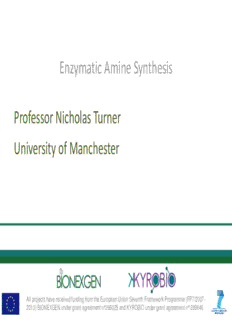
Professor Nicholas Turner University of Manchester Enzymatic Amine Synthesis PDF
Preview Professor Nicholas Turner University of Manchester Enzymatic Amine Synthesis
Enzymatic Amine Synthesis Professor Nicholas Turner University of Manchester • All projects have received funding from the European Union Seventh Framework Programme (FP7/2007- 2013) BIONEXGEN under grant agreement n°266025 and KYROBIO under grant agreement n° 289646 Enzymatic Amine Synthesis Nicholas J. Turner School of Chemistry & Manchester Institute of Biotechnology, University of Manchester, UK Next Generation of Biocatalysis for Industrial Chemical Synthesis Brussels, BE 3rd December 2013 A Network of EU Funded IB Projects • Enhanced collaborations with academic and industrial scientists across the EU. • Providing a real focus for the development of industrially relevant technology. • Training of the next generation of IB scientists for industry and public sector. Amines – Versatile Industrial Chemicals: RNH 2 • Intermediates for pharmaceuticals, agrochemicals • Building blocks for polyamides (e.g. diamines) • Solvents, Cleaning agents • Wood treatment • Personal care • Water treatment • Lubricants • Disinfectants • Traditionally manufactured using chemical process, • e.g. reductive amination, addition of ammonia to olefins • Requires high temp/pressure/pH/metal catalysts Alkaloids Biosynthesis √ Total Synthesis √ Biocatalysis? Synthetic APIs Levocetirizine Solifenacin Telaprevir Biocatalysts for Amine Synthesis 5 Major Themes in Biocatalysis • Biocatalysts (enzymes/whole cells) can replace chemo-catalysts in synthetic routes (e.g. KREDs for ketone reduction). 5 Major Themes in Biocatalysis • Biocatalysts (enzymes/whole cells) can replace chemo-catalysts in synthetic routes (e.g. KREDs for ketone reduction). • Biocatalysts can also enable new synthetic pathways which may be shorter, more efficient and more sustainable. PAL mediated synthesis of perindopril DSM tonne-scale production 96% yield; 99% e.e. Anti-hypertensive B. de Lange et al., ChemCatChem, 2011, 3, 289.
Description: